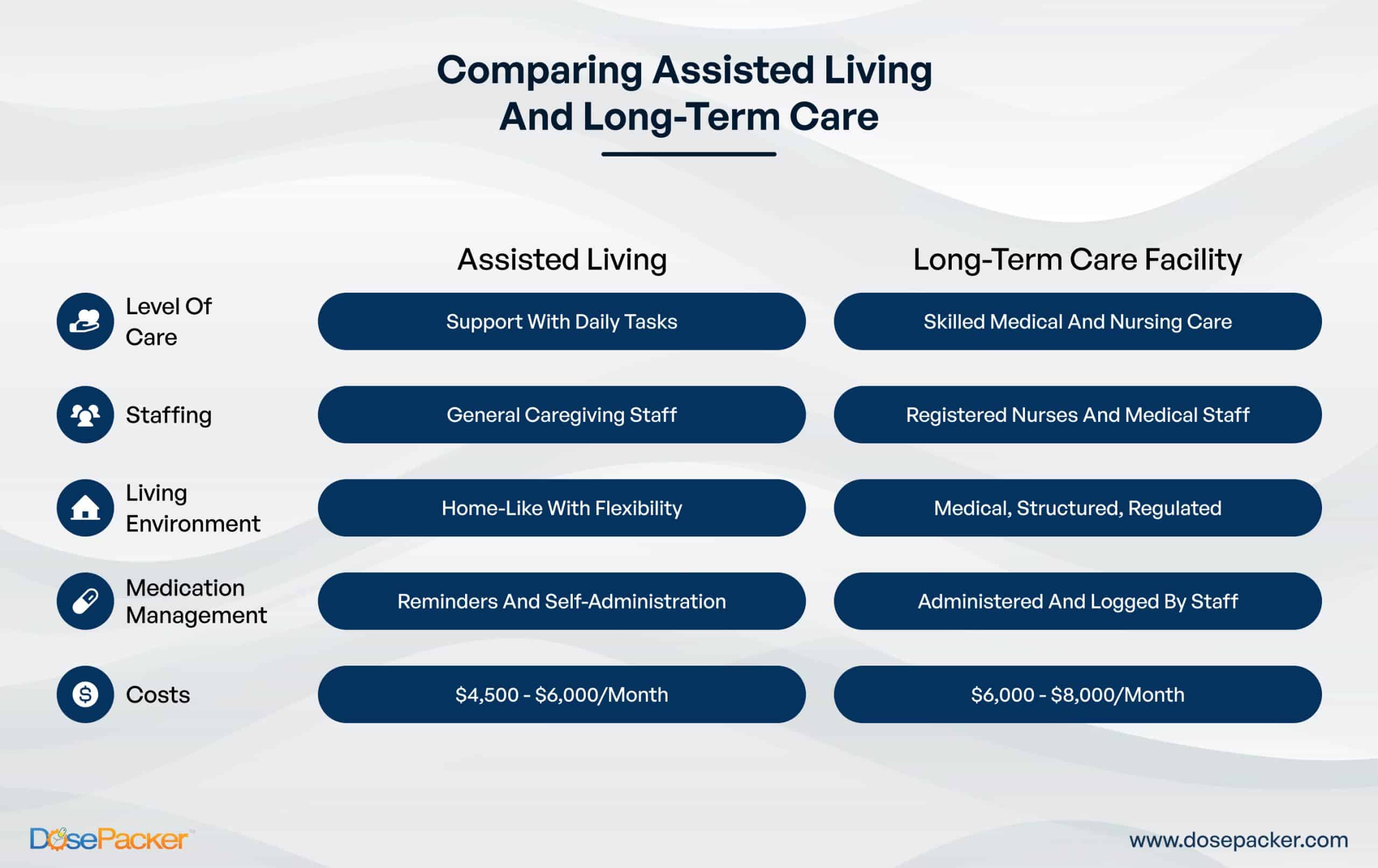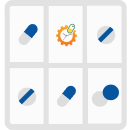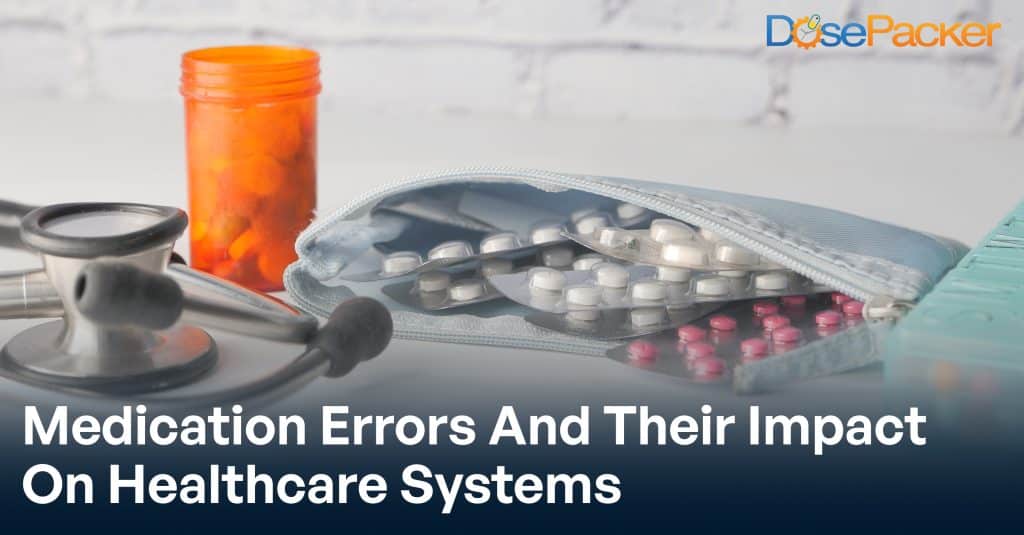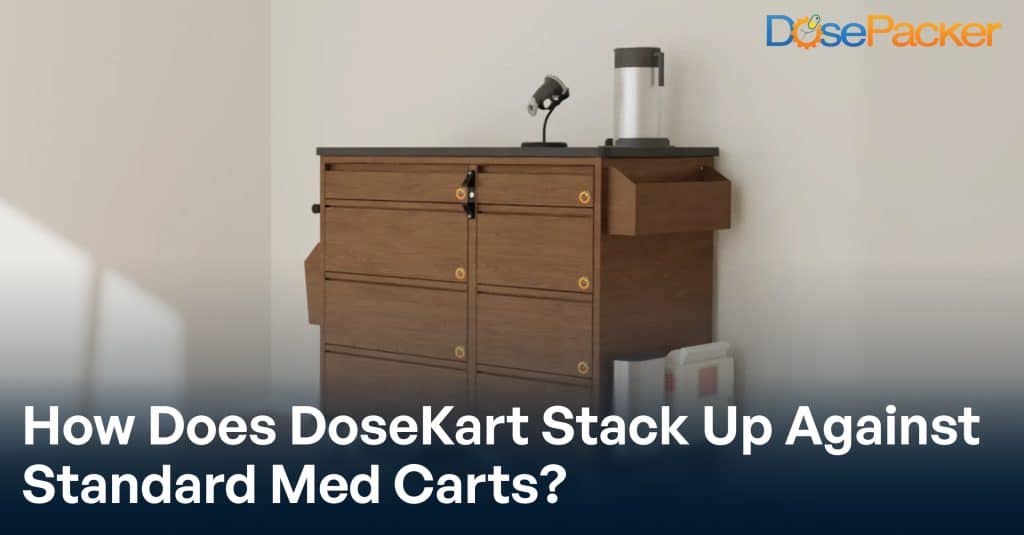Unlock the latest in medication management technology and grow your care community with us.

Choosing the right care for a loved one is one of life’s toughest decisions, and it’s easy to feel unsure about where to start. Let’s start with a reality check: elder caregiving is a national concern. In the U.S., unpaid family caregivers deliver eldercare worth around $600 billion per year, often juggling jobs, emotional strain, and financial pressure – all while caring for aging parents. With so much at stake, knowing whether an assisted living vs a long‑term care facility is the right path can bring clarity and peace of mind.
Think about your loved one’s day-to-day needs. Are they mainly independent, needing a little help? Or do they require constant medical supervision and support? Let’s unpack what each care setting offers and explore how future care trends and smart tools like DosePacker can support both.
What Is Assisted Living?
Assisted living is designed for older adults who are mostly independent but need some daily support. These communities are ideal for individuals who may no longer feel safe or comfortable living entirely on their own, but don’t require full-time medical care.
Residents typically live in private or semi-private apartments with access to shared dining, recreational activities, and wellness programs. Staff are on hand to help with personal care tasks like bathing, dressing, grooming, and mobility. Medication support is also commonly offered, often in the form of reminders or assistance with organizing and taking doses.
The environment in assisted living facilities is home-like and socially enriching. Many communities feature landscaped gardens, activity rooms, and scheduled group outings. It’s not just about meeting physical needs; it’s about creating a supportive space where residents can thrive socially, emotionally, and physically, while still retaining a sense of independence.
What Is Long-Term Care?
Long-term care, often provided in nursing homes or skilled nursing facilities, is suited for individuals with complex, ongoing medical needs. This includes seniors with chronic illnesses, disabilities, or advanced cognitive impairments who need round-the-clock supervision, skilled nursing care, and regular health monitoring.
Unlike assisted living, long-term care facilities are medically intensive environments. Residents are typically under the supervision of licensed nurses and physicians who manage everything from medication administration to rehabilitation services. Care plans are developed to address both medical and daily living needs, such as mobility assistance, feeding, hygiene, and wound care.
These facilities are often equipped to handle conditions such as stroke recovery, late-stage dementia, or post-surgical rehabilitation. The goal is to provide comprehensive support and safety, especially for those who are unable to care for themselves or are at risk of harm if left unsupervised.
Comparing Assisted Living and Long-Term Care
Lets compare assisted living and long-term care facilities as per level of care, costs and other important factors.

Medication Management in Both Settings
Medication management is a critical component of both assisted living and long-term care, but the approach and intensity differ significantly. What remains consistent across both settings is the growing need for smarter, more reliable systems that reduce errors, improve safety, and simplify caregiver workflows.
In assisted living, staff often provide gentle reminders or supervise residents as they take their medications. However, this still leaves room for error, especially for residents with multiple prescriptions or cognitive challenges. Manual tracking, handwritten logs, and over-the-counter medications add layers of complexity that can lead to missed doses or incorrect administration.
In contrast, long-term care facilities generally have stricter protocols. Medications are administered directly by licensed nurses, logged in real-time, and stored securely. But even here, time constraints and manual processes can lead to mistakes.
How Smart Medication Solutions Make a Difference
Managing medications can be stressful and complicated, especially in busy care settings. That’s why tools like DosePacker are game-changers. By offering pre-sorted, time-stamped compliance packs, DosePacker removes the guesswork. Each dose is clearly labeled by date and time, which minimizes risk during administration, especially in high-pressure environments. These packs can be scanned for automated logging, helping facilities maintain audit-ready records and ensuring that every dose is accounted for.
Additionally, DosePacker’s medication adherence solutions help bridge communication between staff and families. Real-time dashboards allow for oversight of missed doses or schedule delays, creating a transparent and proactive approach to care. Whether it’s reminding a semi-independent resident in assisted living or supporting full medication schedules in long-term care, these tools support consistency and accuracy.
By integrating such intelligent systems, facilities can reduce medication errors, support overworked staff, and improve resident outcomes, no matter the level of care being provided.
Real-Life Concerns: Cost, Ease, and Emotional Fit
Let’s be honest, choosing between assisted living and long-term care isn’t just about definitions. It’s about what feels right for your loved one now and as they change.
- Care Needs: For individuals who require assistance but prefer to maintain their independence, assisted living often offers a more comfortable living environment. But when medical needs increase, long-term care may be safer.
- Medication Complexity: Juggling multiple pills? Smart tools mean fewer errors in both settings.
- Budget: Assisted living is often more affordable. But as care needs increase, the costs can rise to match those of skilled nursing facilities.
- Emotional Fit and Community: Assisted living often offers more social options, while long-term care can feel more clinical, but also more medically secure.
There’s no perfect answer, only the right one for your family’s moment in time.
Compassionate Care Starts with the Right Choice
Choosing between assisted living and long-term care isn’t just about checklists or cost comparisons; it’s about your loved one’s daily life, dignity, and comfort. These decisions can feel heavy, and that’s okay. You’re not just selecting a care facility; you’re choosing for your family and support for someone you deeply care about.
Assisted living celebrates independence, offering just the right amount of help when needed. Long-term care, on the other hand, ensures safety and continuous supervision for more complex health needs. Both are valid, and both can be the “right” choice, depending on where your loved one is in their journey.
What matters most is ensuring the support systems are strong. That’s where smart solutions from DosePacker can make a meaningful difference. From medication reminders to pre-sorted compliance packs and real-time monitoring, these tools lift the burden on caregivers and bring clarity to families.
Always remember that you’re doing your best, and with the right care plan and the right tools, you can feel confident that your loved one is supported and safe. Whatever decision you make, make it with care, make it with love, and know that help is always within reach!
Want to know how DosePacker makes daily care smoother and safer? Let’s connect.
































